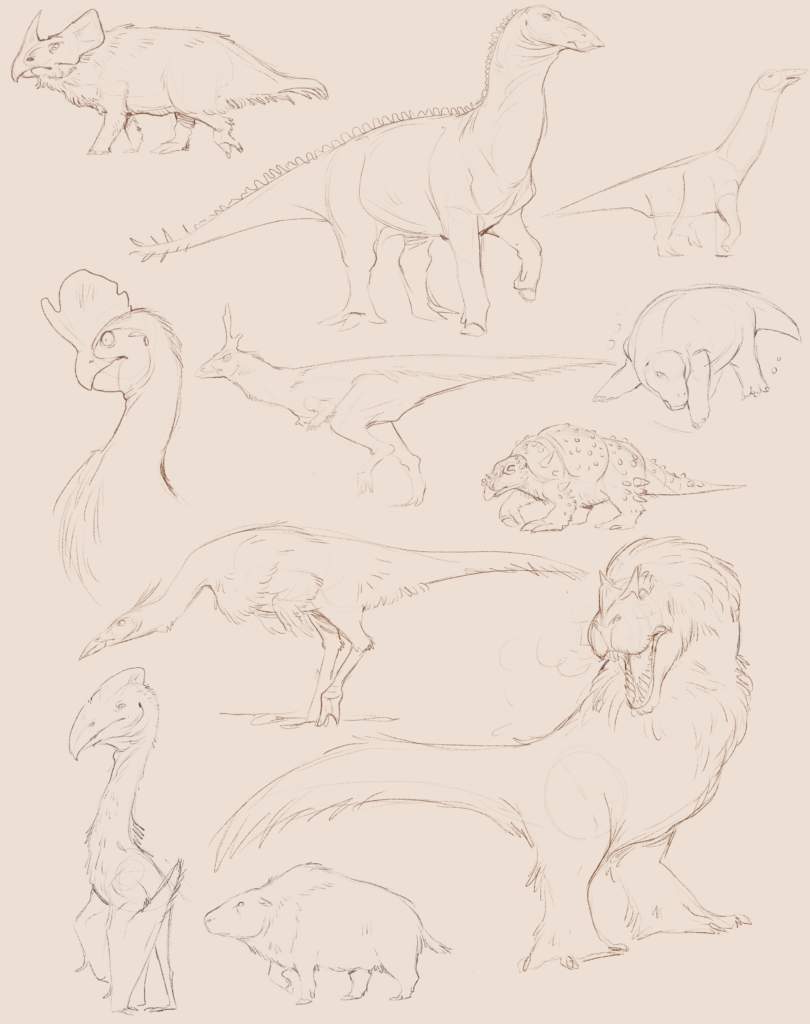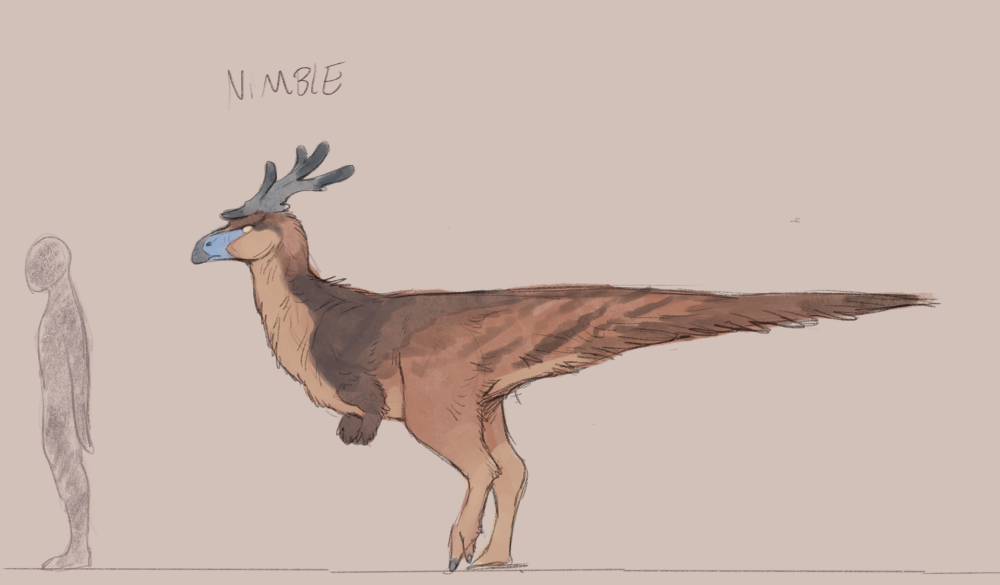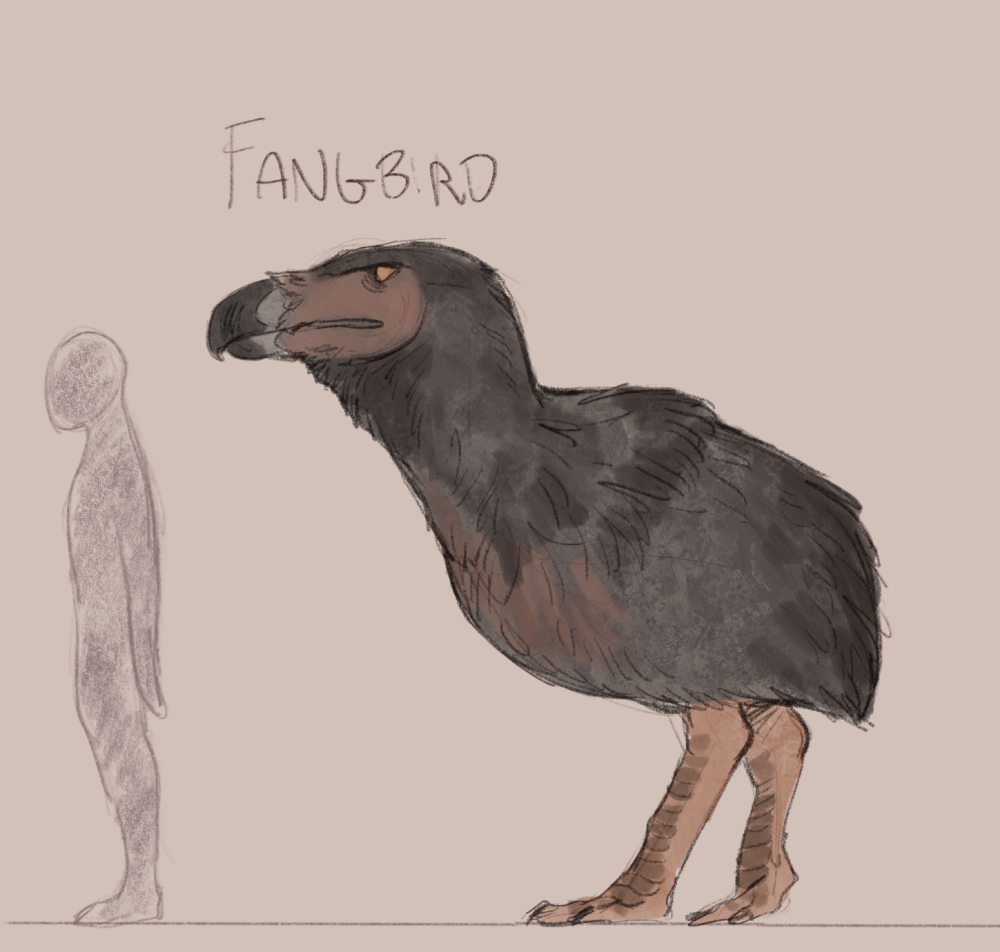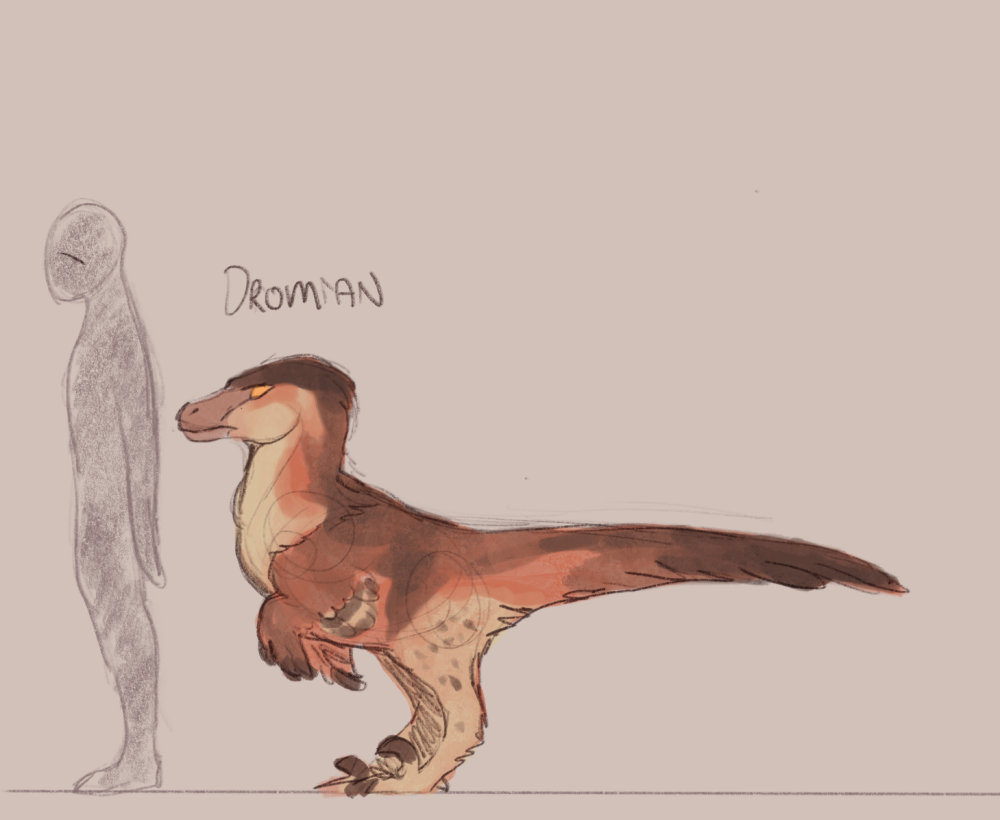A small writing/worldbuilding project I undertook in late 2019-2020 was Dromia, which eventually evolved into its own little narrative. Dromia initially started as a fun experiment, but also maybe a work of spite towards the Pixar film The Good Dinosaur. It follows the same premise, which countless others have delved into and continue to: what would happen if non-avian dinosaurs didn’t die at the end of the Cretaceous?
Now, comes my major disclaimers. I have always been fascinated by speculative evolution/biology, and spend probably more time than I’d like to admit reading projects other folks have made with it (I highly recommend Serina and Birgworld). I am definitely no biologist, though, and my understanding is pretty surface level. I know post-Cretaceous dinosaurs has been done a lot, and likely my interpretations aren’t anything very in-depth in comparison. HOWEVER it IS a project I did for fun, and that’s all that really matters to me. Ultimately, Dromia is a narrative story–it follows characters in a plot, so the spec evo was just some set dressing I had a lot of fun with. One day, if I ever get around to finishing it, I would like to share Dromia in its narrative form, but for this post I wanted to run over some of this set dressing! Because I had a lot of fun with it!
This also ended up being longer than I anticipated, so it’ll probably be broken up into two posts.
The World of Dromia

As mentioned above, Dromia takes place in an alternate “Earth” where non-avian dinosaurs didn’t go extinct. They continued to evolve and grow, and the story centres around a sapient species who call themselves the Dromia. They are descended from dromeosaurs, “raptors”, such as Acheroraptor. Around them is a colourful assortment of other animals. I can’t say exactly what time period this goes to that’s equivalent to ours… all I know is this world is much colder than the Cretaceous, with harsh winters. This does take place in North America, and centres around lots of Hell Creek/N. American Cretaceous species since… that’s what I was researching at the time, for my graphic novel.
I’ll save the star species for the next post, so for now I’ll go over a couple of the other creatures I fleshed out:

Tyrants are, well, the descendants of tyrannosaurs. They are still the kings of food chain, apex predators that the Dromia dreadfully fear. Not too much has changed since their glory days of the Creataceous, though they don’t exactly reach the gargantuan sizes they once did. Their arms have also shrunk considerably, hidden beneath their feather floof. They come in three varieties, depending where you go: to the north is the terrifying Polar Tyrant, the largest of all of them, and the most deadly; the Spotted Tyrant lives in more temperate areas, and is the most common one; and the Lesser Tyrant, the smallest species that shouldn’t be underestimated, as it’s a speedy killer that lives on the plains.





Polar > Spotted > Lesser > Bonus naked Polar (how scandalous) > Height chart
Horned-faces (I never liked that name but couldn’t settle on anything else) are descendants of ceratopsids… but not ones like Triceratops, which died out, but the smaller forms akin to Leptoceratops. Therefore as they grew in size, they took on a lot of similarities to their ancient relatives. The Woolly Horned-face is a common sight on the plains, migrating north and south depending on the year. The stranger variant of this species is the Aquatic Horned-face, which decided to take to the waters and inhabit the lakes in the south.



Woolly and Aquatic Horned-faces (plus height chart)
Rockhides are the descendants of ankylosaurs (I can’t remember exactly if I decided it was only ankylosaurs or if denversaurs were in the picture here too…) The big varieties, the Red Rockhides, are functionally not too different from their Cretaceous forms–if it ain’t broke, don’t fix it. Where they get interesting is in their smaller species–the Green Rockhides are burrowers, using their strengthened front limbs to carve out burrows. These are a favoured prey of Dromia to use their tough hides as armour. I also toyed with smaller aquatic forms of this, too, which you can see in the doodle page up above.


Red and Green Rockhide
Goliaths are the largest land creatures in the Dromia world. Descended from the already large hadrosaurs like Edmontosaurus, they didn’t have much more to go, although they are certainly not as large as some of the dinosaurs of the past. As they grew, they took a page out of the extinct sauropod book, growing longer necks and broad beaks to shear off foliage. Not much can stand up to a fully grown Goliath.


Goliath plus a height chart
Nimbles fall in the same family as the Goliaths, though they’re related to smaller ornthipods like Thescelosaurus. Although they grew in size, their true accomplishment was speed, as some of the fastest creatures in this world. They mostly stick to the woods, and though both genders grow crests, the males tend to have the more ornate ones. These guys are basically to fill out the role of “deer”. They’re often a rite of passage for young hunting Dromians.

Male nimble.
Fangbirds are descendent of… well, basically birds with teeth. The Fangbirds shirked their flight to become fearsome land predators, using their deadly combo of hooked beak and teeth to hold on to and tear apart prey. They’re a nuisance to the Dromia, often stealing from their flocks of domesticated animals, not to mention being a deadly thing to deal with themselves.

Kites are a general name for all surviving pterosaurs. Pterosaurs haven’t completely died out, though they’ve diversified into some weird niches as birds dominate most of the others. The largest Kite is the Scavenger Kite which functions pretty much as a vulture, swooping on carcasses to devour it. I never got around to designing more of them, unfortunately, but I imagine plenty of fruit-eating, tree climbing species, keeping to the trees as birds fly the skies.

Stilts are the descendants of ornithomimids, and contend with Nimbles as the fastest creatures here. Though not much has changed about them, plenty of Stilts are actually domesticated by the Dromia, acting as steeds to carry them far places. These domesticated forms can take on a variety of looks–the example I have is just the wild species. I never got around to designing the domesticated ones properly… I also did toy with other wild species that were heron-like with long beaks.


Wild Stilt and sketch of the heron-like Stilt
Rows and Carns are mammals, because hey, those are still around, too. Admittedly, though, my weak point is definitely in ancient mammals, so I don’t have as much fleshed out when it comes to them. Rows are a domesticated species that many Dromians raise on farms, providing everything from milk, bone, hide, and meat. Carns are northern predators, another danger Dromians face, as they too like picking off Rows for an easy meal. They also have incredible nighttime sight, something Dromians lack.


Some other creatures I designed but never fully finished or named or anything, probably because at this point I was invested in writing Dromia instead of worldbuilding… Plus some bonus sketches too (this includes another little Kite)




And finally, that brings us… to the Dromians themselves!

Unfortunately, this post is getting LONG, so I’ll return to them in another one. I hope you enjoyed my little foray into spec evo and creature design, it definitely kept me distracted (and perhaps a little bit sane) during the start of 2020 and all the garbage it unloaded there. I would love to return to worldbuilding this some more in the future.


Leave a Reply